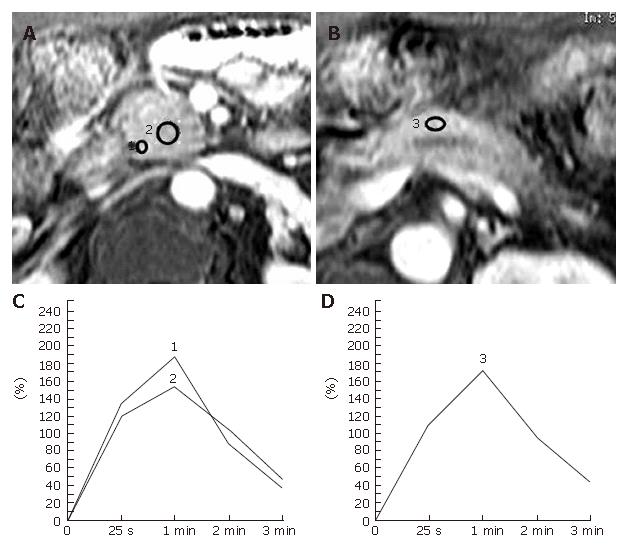Copyright
©2007 Baishideng Publishing Group Co.
World J Gastroenterol. Feb 14, 2007; 13(6): 858-865
Published online Feb 14, 2007. doi: 10.3748/wjg.v13.i6.858
Published online Feb 14, 2007. doi: 10.3748/wjg.v13.i6.858
Figure 4 Tumor-forming pancreatitis in a 70-year-old man with a long history of alcohol abuse.
The patient underwent a pylorus-preserving pancreaticoduodenectomy together with lymphadenectomy for a suspected pancreas head carcinoma associated with obstructive jaundice and was confirmed to be chronic pancreatitis after surgery. A, B: Dynamic contrast-enhanced MRI images of the pancreas. The ROIs are placed at the pancreatic mass (No.2 ROI) and the pancreatic parenchyma both proximal (nNo.1 ROI) and distal (No.3 ROI) to the mass lesion; C: Both of the pancreatic TICs obtained from the No.1 and no.2 ROIs as in Figure 4A demonstrate type-II; D: Pancreatic TIC obtained from the No.3 ROI as in Figure 4B also shows type-II.
- Citation: Tajima Y, Kuroki T, Tsutsumi R, Isomoto I, Uetani M, Kanematsu T. Pancreatic carcinoma coexisting with chronic pancreatitis versus tumor-forming pancreatitis: Diagnostic utility of the time-signal intensity curve from dynamic contrast-enhanced MR imaging. World J Gastroenterol 2007; 13(6): 858-865
- URL: https://www.wjgnet.com/1007-9327/full/v13/i6/858.htm
- DOI: https://dx.doi.org/10.3748/wjg.v13.i6.858









